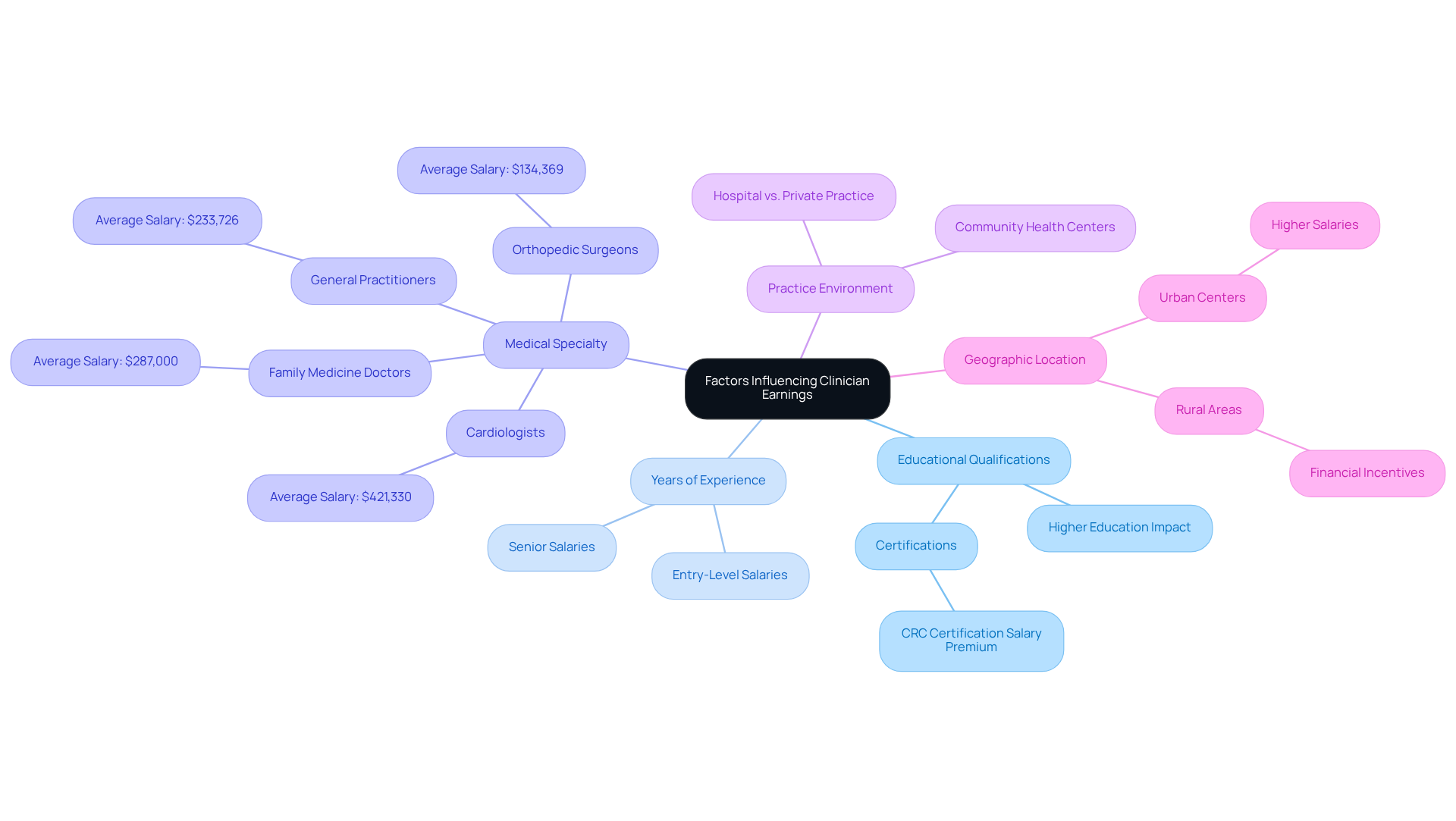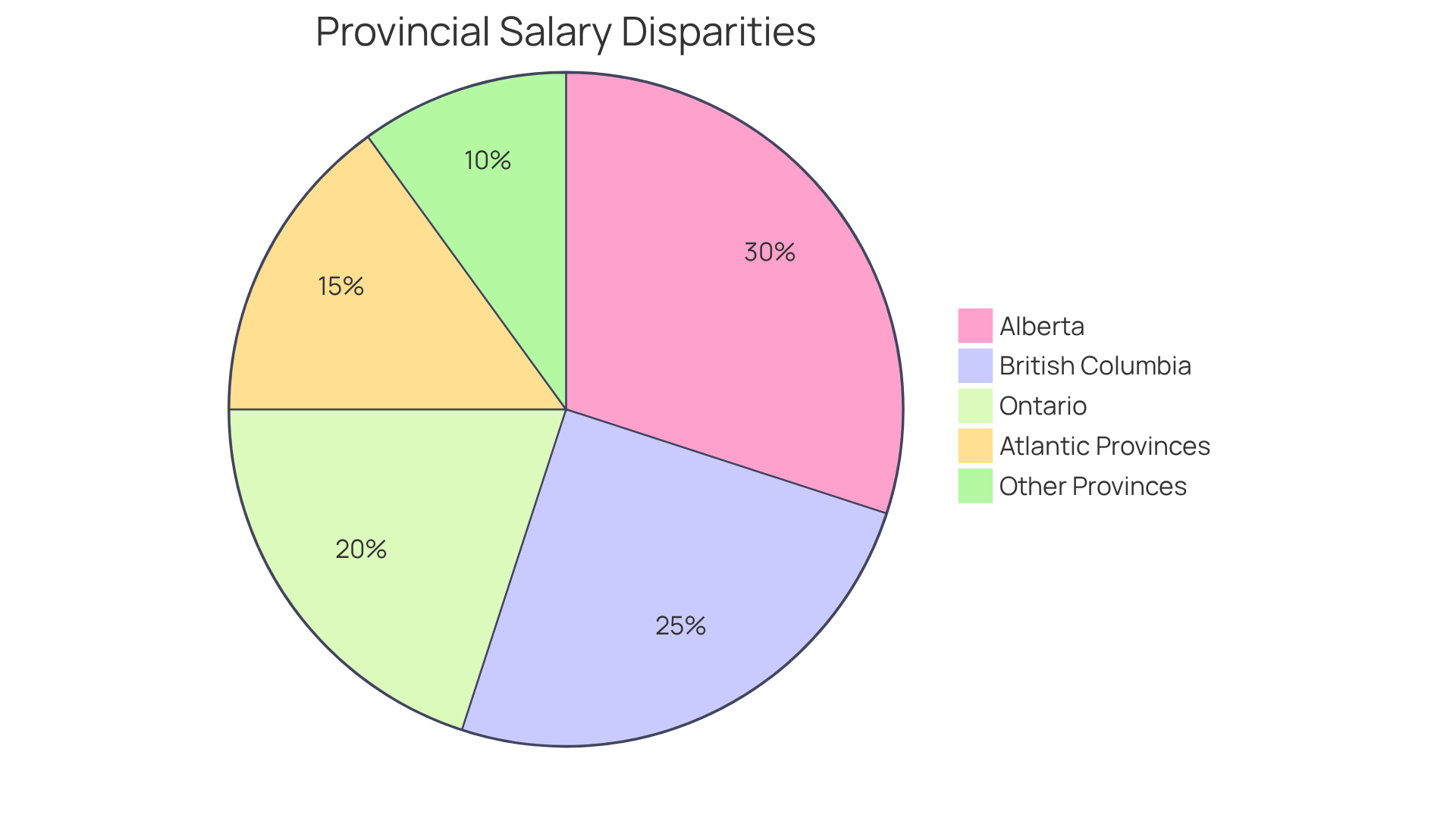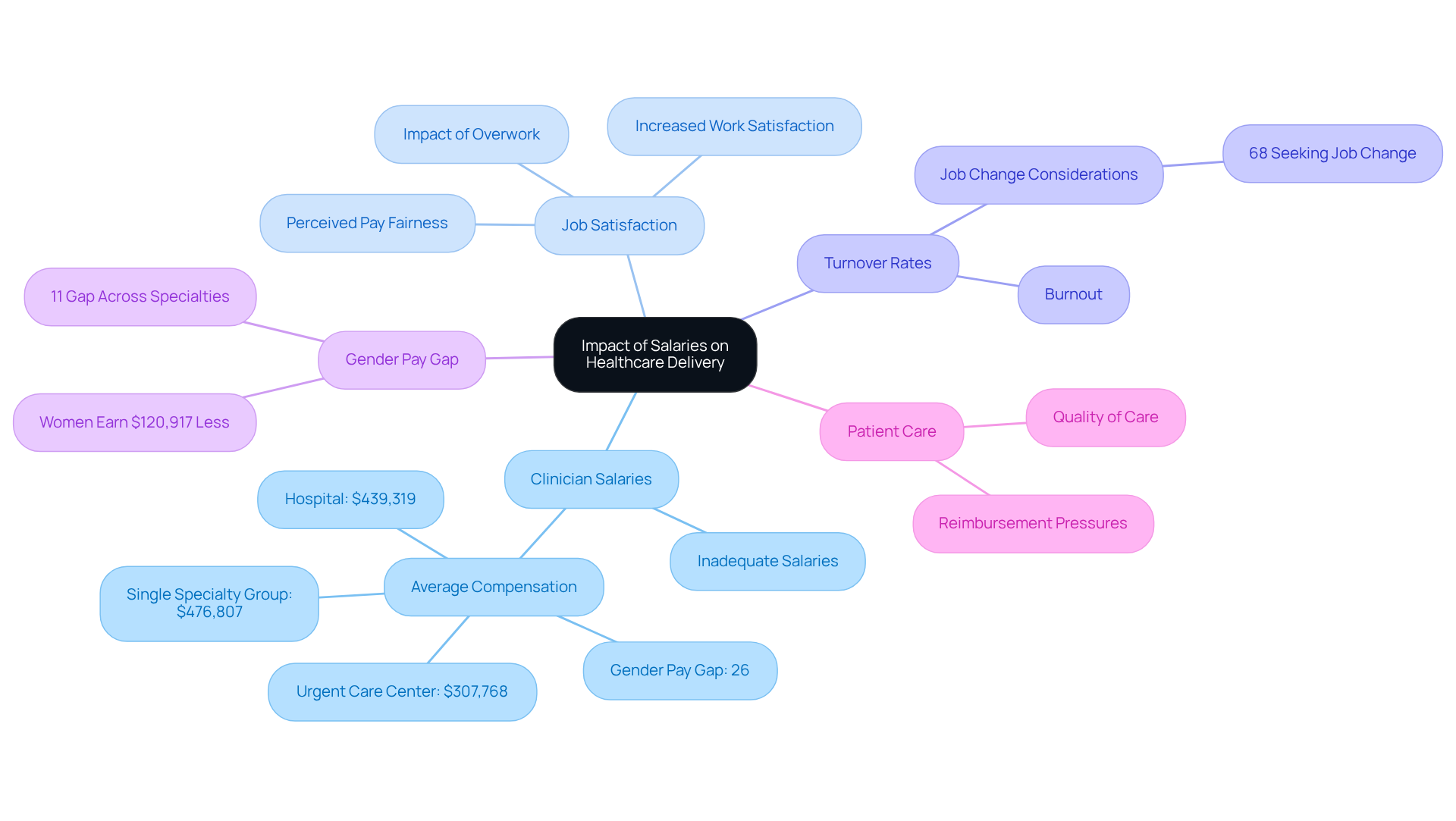Overview
In Canada, clinicians encounter a range of salary levels influenced by various factors, including their specialty, experience, geographic location, and payment models. This complexity can lead to emotional challenges, as many healthcare providers strive to balance their financial needs with their commitment to patient care. As we look ahead to 2025, the average compensation is projected to be around CA$79,871, yet this figure masks significant disparities.
Consider specialists, such as cardiologists, who often earn much more than their peers. This disparity raises questions about equity and the overall satisfaction of clinicians in their roles. Regional differences and payment structures play crucial roles in shaping earnings, which can directly impact both clinician satisfaction and the quality of care provided to patients. How do these factors affect your daily practice and your connection with patients?
It's essential to recognize that these financial factors can weigh heavily on healthcare providers. By understanding the implications of salary variations, we can work towards solutions that enhance both clinician well-being and patient care. Together, we can advocate for changes that support fair compensation and foster an environment where healthcare professionals feel valued.
As we reflect on these challenges, let’s engage in a conversation about potential solutions. What changes do you believe could improve the situation for clinicians across Canada? Your insights are vital as we strive for a more equitable healthcare system.
Introduction
Understanding clinician salaries in Canada unveils a landscape filled with emotional challenges, shaped by various factors like specialty, experience, and geographic location. As the demand for healthcare professionals evolves, the projected average compensation of CA$79,871 in 2025 raises significant concerns about the financial realities faced by these essential workers. How do disparities in pay across provinces and specialties affect not only the quality of care but also the wellbeing of healthcare providers?
Exploring these dynamics sheds light on the economic challenges within our healthcare system. It emphasizes the need for equitable remuneration, which is crucial for supporting both clinicians and the patients they serve. By addressing these disparities, we can foster a more supportive environment that values the contributions of healthcare professionals and enhances the care provided to all.
Defining Clinician Salaries in Canada
In Canada, understanding how much do clinicians make involves examining the remuneration that healthcare professionals, including physicians, nurses, and allied health workers, receive for their invaluable services. This compensation varies significantly based on factors such as specialty, experience, geographic location, and how much do clinicians make. In 2025, the average compensation for healthcare professionals is projected to be around CA$79,871 per year. Entry-level roles are expected to earn approximately CA$63,051, while senior-level healthcare workers, boasting over eight years of experience, average around CA$110,498. The median total compensation for a healthcare professional stands at CA$80K per year, with the lowest wage for a healthcare worker in Canada being CA$58,937 annually.
The structure of healthcare provider salaries in Canada typically includes a mix of:
- Fee-for-service payments
- Salary-based remuneration
- Alternative payment models
Fee-for-service agreements allow healthcare providers to charge for each service rendered, while salary-based payments offer a steady income, often seen in hospital settings. Alternative payment models, such as capitation or blended payment systems, aim to incentivize quality care over the sheer volume of services provided.
Understanding how much do clinicians make is crucial, as this reflects the economic realities faced by healthcare providers. For instance, clinicians in Ontario earn an average hourly rate of CA$43, prompting the inquiry of how much do clinicians make in relation to the national average. However, the cost of living in Ontario is 8% higher than the Canadian average. This disparity highlights the importance of considering regional economic factors when evaluating compensation proposals.
Moreover, the evolving landscape of medical remuneration in Canada raises questions about how much do clinicians make, indicating a trend toward higher earnings, with an estimated 6% increase anticipated over the next five years. This upward trajectory in clinician compensation is vital for attracting and retaining skilled professionals, ultimately influencing the quality of patient care within the healthcare system. How can we support our healthcare providers in navigating these changes and ensuring they feel valued for their essential contributions?

Factors Influencing Clinician Earnings
In Canada, how much do clinicians make is influenced by a range of factors, including educational qualifications, years of experience, and the specific medical specialty practiced. It’s important to recognize the emotional challenges that healthcare providers face as they navigate their careers. For example, experts such as cardiologists and orthopedic surgeons earn significantly more than general practitioners, which raises the question of how much do clinicians make in these specialized fields, highlighting the extensive training and proficiency required. Did you know how much do clinicians make, as cardiologists can earn over $421,330 each year while orthopedic surgeons average $134,369? In contrast, general practice physicians in Canada earn around $233,726 CAD as of January 23, 2024, prompting an inquiry into how much do clinicians make in this specialty.
The practice environment also plays a crucial role in shaping earnings. Many people are curious about how much do clinicians make, as those working in hospitals typically receive greater compensation compared to those in private practices or community health centers. Furthermore, geographic location significantly affects how much do clinicians make, leading to compensation variations. Urban centers often offer attractive remuneration to attract talented professionals, raising interest in how much do clinicians make, with cities like Toronto and Vancouver standing out. Conversely, rural areas may provide financial incentives, such as signing bonuses or student loan repayment programs, to encourage healthcare professionals to establish their practices in less populated regions, which can influence how much do clinicians make.
We cannot overlook the impact of education on how much do clinicians make in terms of earning potential. Higher education and specific certifications can have a direct impact on how much do clinicians make. For instance, nurse practitioners and clinical research coordinators often see substantial pay increases when they pursue further qualifications. In 2020, family medicine doctors in Canada grossed $287,000 CAD, prompting inquiries about how much do clinicians make in this specific field.
Overall, the interplay of these factors creates a dynamic environment for determining how much do clinicians make across Canada. If you’re considering furthering your education or exploring different practice environments, remember that each choice can significantly impact your career and financial well-being.

Regional Salary Variations Among Canadian Clinicians
The wage discrepancies among Canadian medical professionals can evoke significant concern, as these differences are influenced by factors such as cost of living, demand for medical services, and provincial funding structures. Have you ever wondered how these disparities affect the well-being of healthcare providers? For example, practitioners in provinces like Alberta and British Columbia often report higher compensation compared to their counterparts in the Atlantic provinces. This gap can largely be attributed to the elevated cost of living in urban centers and the competitive nature of medical markets.
Moreover, rural areas may offer enhanced compensation or bonuses to attract medical professionals, showcasing the urgent need for services in underserved regions. Understanding these variations is crucial for policymakers who aim to ensure equitable access to healthcare across the country. By addressing these disparities, we can foster a more supportive environment for all healthcare providers, ultimately leading to better patient care. Let's continue to engage in conversations about how we can bridge these gaps and support our healthcare community.

Impact of Salaries on Healthcare Delivery and Provider Wellbeing
Understanding how much do clinicians make significantly impacts both patient care and provider wellbeing. To attract and retain talented individuals within the healthcare system, it’s essential to offer competitive remuneration, leading to the inquiry of how much do clinicians make. When healthcare professionals consider how much do clinicians make and feel their compensation is adequate, they tend to experience greater job satisfaction, which is closely linked to improved patient care and outcomes. Conversely, knowing how much do clinicians make is crucial, as inadequate salaries can lead to burnout and higher turnover rates, disrupting the continuity of care for patients.
Financial stress not only hinders a healthcare professional's ability to engage fully with patients but also detracts from the overall quality of care provided. This underscores how much do clinicians make in fostering a caring and efficient healthcare environment through equitable remuneration. In Canada, the relationship between how much do clinicians make and job satisfaction is especially clear, with studies showing that perceived pay fairness correlates with increased work satisfaction and reduced turnover intentions.
Consider the gender pay gap, which exceeded 11% across all specialties examined in 2024. Such disparities can have a profound effect on job satisfaction. Additionally, 68% of doctors are either seeking a job change or contemplating early retirement due to excessive workloads, highlighting how crucial remuneration is for retention. Moreover, 81% of physicians believe that reimbursement policies have contributed to the decline of independent practices, further impacting job satisfaction.
Addressing how much do clinicians make in terms of compensation disparities is vital for maintaining a satisfied and healthy physician workforce, which ultimately benefits patient care. As Audiey C. Kao MD, PhD, pointed out, perceived pay fairness is associated with greater work satisfaction. This emphasizes the importance of addressing these issues, fostering a supportive environment where healthcare professionals can thrive.

Conclusion
Understanding the compensation landscape for clinicians in Canada is essential for recognizing the value of healthcare professionals and the economic realities they face. Clinicians often grapple with emotional and financial challenges, which can impact their dedication to patient care. The article highlights that clinician salaries are influenced by various factors, such as specialty, experience, and geographic location, ultimately shaping the financial well-being of those dedicated to patient care. With projected average earnings of CA$79,871 in 2025, it is clear that the remuneration of healthcare providers is not only a reflection of their expertise but also a critical component in maintaining a robust healthcare system.
Key insights reveal significant disparities in earnings based on specialization, practice environment, and regional differences. For instance, specialists like cardiologists and orthopedic surgeons command higher salaries compared to general practitioners, while urban centers often offer more attractive compensation packages than rural areas. This disparity can leave many feeling undervalued. Additionally, the evolving landscape of clinician remuneration indicates a trend toward higher earnings, which is vital for attracting and retaining skilled professionals. The interplay of these factors underscores the importance of equitable compensation in fostering job satisfaction and ensuring quality patient care.
Ultimately, it is crucial to engage in ongoing discussions about clinician salaries and their impact on healthcare delivery. Addressing disparities in compensation not only supports healthcare providers but also enhances the overall quality of care patients receive. By advocating for fair remuneration, stakeholders can help create a healthier, more sustainable healthcare environment that values the contributions of all clinicians. Together, we can ensure that they feel appreciated and motivated in their vital roles. Let's continue this important conversation, recognizing that every clinician deserves to be valued for their dedication and hard work.




